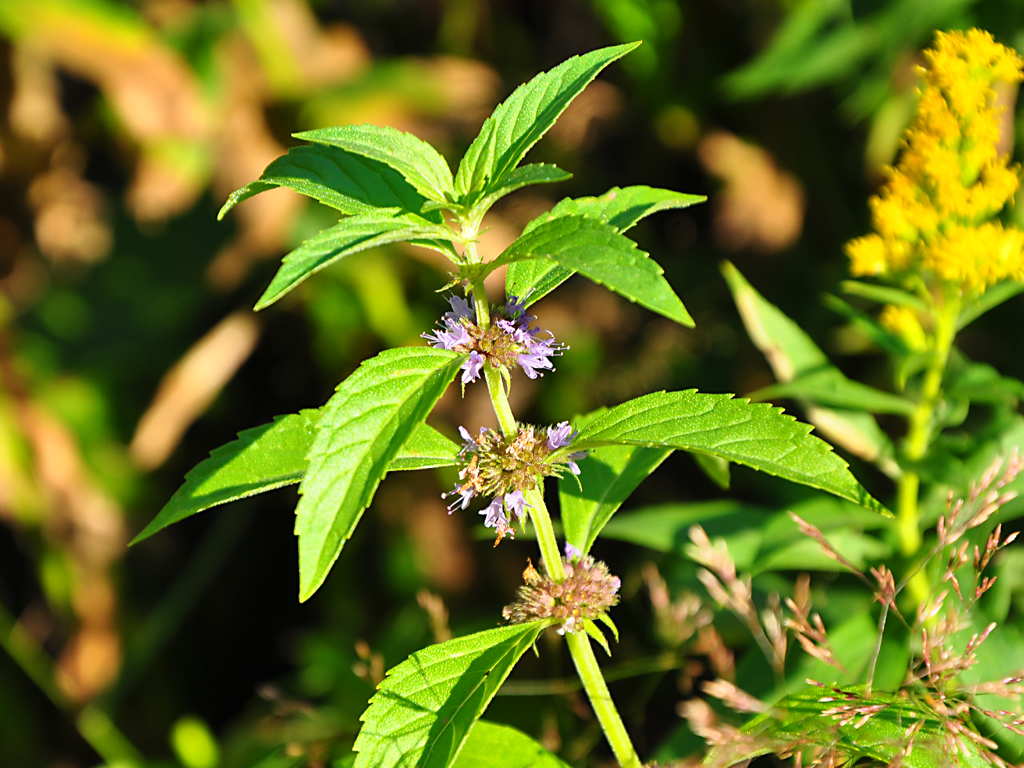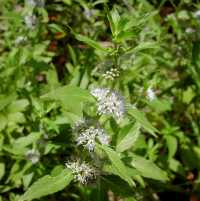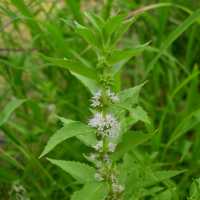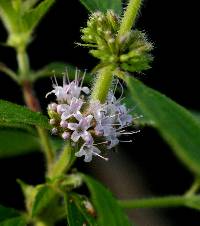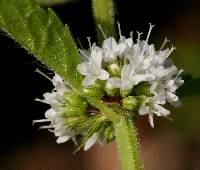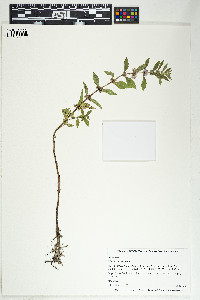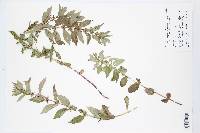|
|
|
|
Family: Lamiaceae
wild mint
[Mentha arvensis subsp. borealis (Michx.) Roy L.Taylor & MacBryde, moreMentha arvensis subsp. haplocalyx (Briq.) Briq., Mentha arvensis subsp. parietariifolia (Becker) Briq., Mentha arvensis var. canadensis (L.) Kuntze, Mentha arvensis var. glabrata (Benth.) Fernald, Mentha arvensis var. lanata Piper, Mentha arvensis var. sativa Benth., nom. superfl., Mentha arvensis var. villosa Strail, Mentha glabrior (Hook.) Rydb., Mentha penardii (Briq.) Rydb.] |
Stems ascending or erect, 2-8 dm, pubescent with few to numerous, short and retrorse to longer and more spreading hairs, often glabrous between the angles; lvs short- petiolate, the blade 2-8 cm נ6-40 mm, glabrous or hairy, serrate, acuminate, with several pairs of lateral veins, rather narrowly ovate to more often somewhat rhombic-elliptic, those of the infl, at least, tending to be cuneately tapered to the petiole; verticils compact, axillary to the scarcely reduced (middle and) upper lvs, and separated by internodes of fairly ordinary length; cal pubescent, 2.5-3 mm; cor white to light purple or pink, 4-7 mm, rarely casually 5-lobed; 2n=24-96. Moist places, especially along streams and shores; circumboreal, in Amer. s. to N.C., Mo., and Calif. Native Amer. and e. Asian plants, as here described, are var. canadensis (L.) Kuntze (var. glabrata; var. villosa). The European var. arvensis, with the lvs of the infl relatively broader, more ovate, and somewhat broadly rounded to the petiole, is intr. from Nf. to Que. and Pa., but extremes of one var. could pass for the other. Gleason, Henry A. & Cronquist, Arthur J. 1991. Manual of vascular plants of northeastern United States and adjacent Canada. lxxv + 910 pp. ©The New York Botanical Garden. All rights reserved. Used by permission. Martin and Hutchins 1980, Welsh et al. 1993, Kearney and Peebles 1969 Duration: Perennial Nativity: Native Lifeform: Forb/Herb General: Aromatic perennial herb, 15-80 cm tall, from creeping rhizomes and/ or stolons; stems square in cross section, erect, simple or branching, and glabrate or hairy, with the angles more pubescent than sides. Leaves: Opposite and short-petiolate; blades elliptic to lanceolate or ovate, 1-8 cm long and 1-3 cm wide, with serrate margins; surfaces glandular-punctate. Flowers: Lavender to white, in dense clusters in the axils of the upper leaves; calyx a tube topped with 5 triangular teeth, the entire calyx about 3 mm long, usually pubescent and glandular; corolla 2-lipped, purplish to pinkish or white, 4-6 mm long, about twice as long as the calyx. Fruits: Nutlets 4, oviod, smooth. Ecology: Found in moist to damp soil along creeks and slow moving water from 5,000-9,500 ft (1524-2896 m); flowers June-September. Notes: The only native wild mint in the region. It smells distinctly minty and is edible, only a bit less sweet than the cultivated varieties. Distinguish it from other mints (Mentha spp) by its flowers which are only found in clusters at the bases of the leaves. Other Mentha spp in the region are escaped cutivars (M. spicata, spearmint; M. X piperita, peppermint; and M. X. rotundifolia, Egyptian mint) and all have flowers in spikes at the tips of stems and branches. Ethnobotany: Wide range of medicinal uses: a kidney aid, antiemetic, heart medicine, and sedative; given to treat fever, coughs, colds, flu, headaches, pain, swelling, rheumatism, arthritis, pneumonia, indigestion; culinary uses including as a spice and a tea; also used as a love medicine, a disinfectant, a bug repellant, and to disguise the human scent when hunting. Etymology: Mentha is the Latin name for the unfortunate Greek nymph Mentha who was turned into a mint plant; arvensis means of the fields. Synonyms: Mentha arvensis subsp. borealis, M. arvensis var. canadensis, M. arvensis var. glabrata, M. arvensis subsp. aplocalyx, M. arvensis var. lanata, M. arvensis var. sativa, M. arvensis var. villosa, M. canadensis, M. gentilis, M. glabrior, M. penardii Editor: SBuckley 2010, AHazelton 2017 |
|
|
|


